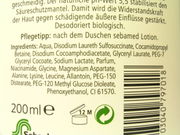- Period after Opening
-
Die Verwendungsdauer (englisch: period after opening, PAO) gibt an, wie lange ein Kosmetikprodukt nach dem Öffnen verwendet werden kann, ohne schädlich für den Verbraucher zu sein.
Zur Kennzeichnung auf Produkten dient ein Symbol, das einen offenen Cremetopf darstellt, gefolgt von dem Zeitraum. Ausgedrückt wird der Zeitraum dabei in Monaten (Abkürzung M) und/oder Jahren (Abkürzung A).
In der Europäischen Gemeinschaft wurde die Pflicht zur Angabe der Verwendungsdauer durch die EG-Richtlinie 2003/15/EG[1] im Jahr 2003 eingeführt. Das Symbol wurde in der Richtlinie 2003/80/EG[2] festgelegt. Betroffen sind kosmetische Mittel mit einer Mindesthaltbarkeit von mehr als 30 Monaten. Für Produkte, die nicht länger als zweieinhalb Jahre haltbar sind, ist ein Mindesthaltbarkeitsdatum anzugeben, vgl. die Kosmetikrichtlinie[3].
Die Pflicht zur Verwendungsdauer-Angabe wurde in Deutschland durch eine Verordnung vom 6. Oktober 2004[4] in nationales Recht umgesetzt; sie ist in § 5 Abs. 1 Satz 1 Nr. 2a, Abs. 2a Kosmetik-Verordnung festgelegt. Die Umsetzung in Österreich erfolgte durch die Kosmetikkennzeichnungsverordnungsnovelle 2005[5]; die Bestimmungen zur Verwendbarkeitsdauer sind in § 4 Abs. 1 Nr. 5a Kosmetikkennzeichnungsverordnung zu finden.
Siehe auch
- Verfalldatum/Haltbarkeit bei Medizinprodukten/Pharmazeutika
Weblinks
- Fragen/Antworten „Haltbarkeit nach dem Öffnen“ (Europäische Kommission)
Fußnoten
- ↑ Richtlinie 2003/15/EG des Europäischen Parlaments und des Rates vom 27. Februar 2003 zur Änderung der Richtlinie 76/768/EWG des Rates zur Angleichung der Rechtsvorschriften der Mitgliedstaaten über kosmetische Mittel; Internetfundstelle (via EUR-Lex)
- ↑ Richtlinie 2003/80/EG der Kommission vom 5. September 2003 zwecks Einführung des Symbols für die Verwendungsdauer der kosmetischen Mittel in Anhang VIIIa der Richtlinie 76/768/EWG des Rates; Internetfundstelle (via EUR-Lex)
- ↑ Richtlinie 76/768/EWG des Rates vom 27. Juli 1976 zur Angleichung der Rechtsvorschriften der Mitgliedstaaten über kosmetische Mittel; Internetfundstelle (via EUR-Lex)
- ↑ Verordnung zur Änderung der Kosmetik-Verordnung und zur Änderung weiterer lebensmittelrechtlicher Vorschriften, 6. Oktober 2004, BGBl. I 2580; Internetfundstelle (via bgblportal.de)
- ↑ 28. Verordnung des Bundesministers für Wirtschaft und Arbeit, mit der die Verordnung über die Kennzeichnung kosmetischer Mittel geändert wird, BGBl. II Nr. 28/2005; Internetfundstelle
Wikimedia Foundation.


